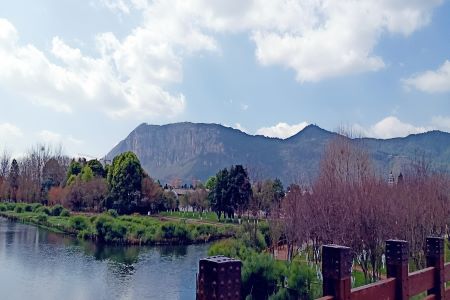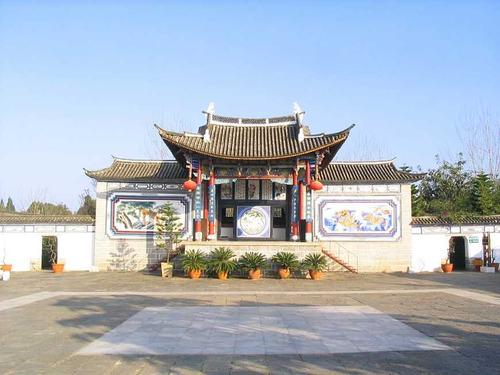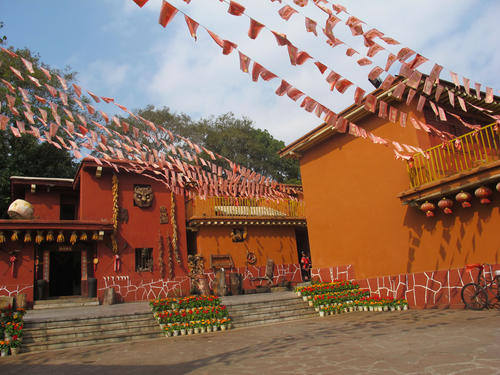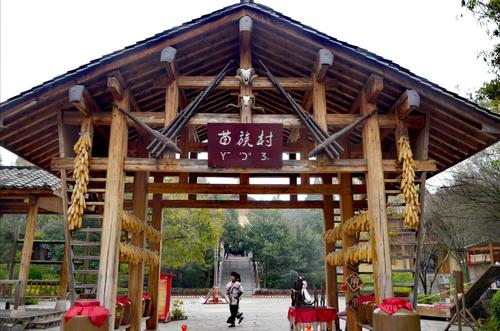Chinese Name: 云南民族村 Pronunciation: Yúnnán Mínzú Cūn
Service Hours: 9:00-18:00
Best Visiting Time: All seasons
Suggested Visiting Hours: 3-5 Hours
Occupied Area: 0.89 square kilometers
Popular Activities: Water Splashing Festival, the Torch Festival
Address: No. 1310, Dianchi Road, Xishan District, Kunming City, Yunnan Province, China
Village Function: A place to know about the customs, buildings, festivals, cultural heritage of ethnic minorities in Yunnan Province
| Tourists | Ticket Price |
| Adults | 90 yuan |
| Children (aged between 6 to 18) |
45 yuan |
| Seniors (aged between 60 to 70) |
1. Children below 1.2(including) meters or under 6(including) years old are free of charge.
2. Seniors over 70(including) years old with valid certificate are free of charge.
| Performances | Time | Venue |
| The Call of the Yunnan-Guizhou Plateau | 14:40-15:20 | Dian Lake Stage |
| Elephant Show | 11:00-11:30; 13:30-14:00; 16:30-17:00 |
Elephant Square |
| Seven-color Clouds | Green Cloud 9:30-9:50; 11:30-11:50; 16:10-16:30 |
Achang Court |
| Blue Cloud 10:10-10:30; 11:20-11:40; 17:00-17:20 |
Knife Square | |
| Black Cloud 10:30-10:50; 12:20-12:40 16:00-16:20 |
Va Square | |
| Red Cloud 10:40-11:00; 13:20-13:40 16:10-16:30 |
Yi Court | |
| Orange Cloud 11:00-11:20; 16:30-16:50 |
Lahu Square | |
| White Cloud 10:30-10:50; 12:40-13:00 17:00-17:20 |
Bai Square | |
| Purple Cloud 11:30-11:50; 16:30-16:50 |
Mosuo Home | |
| Terrace Beyond the Cloud 10:50-11:10; 16:30-16:50 |
Hani Square | |
| Customs of Dai Nationality 11:00-11:20; 15:50-16:10 |
Bamboo Tower of Dai Nationality |

Situated at the bank of the Dian Lake, the southwest of Kunming, Yunnan Nationalities Village covers an area of 0.89 square kilometers (including 0.31 square kilometers of water area). The village is a 4A class national tourist area and is reputed as the window to demonstrate the culture and customs of ethnic minorities in Yunnan Province.
This village boasts 25 ethnic minorities, such as the Bai nationality, the Dai nationality, the Yi nationality, etc. The village restores and exhibits the unique cottages, buildings, living environment of ethnic minorities, which is the epitome of nationalities distributed in Yunnan Province.
Built in 1992, Yunnan Nationalities Village has received many honors. It was successively granted as “National 4A Scenic Spot”, “National Tourism Standardization Demonstration Unit”, and “National Cultural Industry Demonstration Base”. The CIOFF under the UNESCO selected Yunnan Nationalities Village as one of the “Folk Traditional Culture and Art Base in China”.
Up to now, over 30 intangible cultural heritages here have been listed in the list published by the UNESCO.
| Festivals | Time | Ethnic Minorities | Activities |
| Tibetan New Year | January 1st to January 15th of the Tibetan calendar | The Tibetan | Worship and dress show of the Tibetan nationality |
| Jumping Flower Festival (Flowery Mountains Festival) | The second to the seventh day of the first lunar month |
The Miao | Singing in antiphonal style and Lusheng dancing |
| Sanduo God Festival | The eighth day of the second lunar month |
The Naxi | Naxi woodcarving, a memorial ceremony for Sanduo God |
Sanyuesan |
The third day of the third lunar month | The Zhuang | Imitation show of Third Sister Liu, to throw an embroidered ball |
| Sanyue Street Festival (Third Month Fair) | The fifteenth day to the twentieth day of the third lunar month | The Bai | A memorial ceremony and singing in antiphonal style |
| The Water Splashing Festival | April 13th-15th | The Dai | Water-Splashing and dragon boat race |
The Torch Festival |
The twenty-fourth day to the twenty-sixth day of the sixth lunar month |
The Yi, Bai, Naxi, Jino, Lahu |
Drinking and singing, campfire party, and fireworks display |

Covering an area of 42,000 square meters, the Bai Nationality Village is dotted with traditional folk residences with cornices and bucket arch. “Three Lanes and a Screen Wall” is the typical building style of the Bai nationality. It is similar to the Beijing quadrangle courtyard (Siheyuan). This type of house constitutes three lanes and a screen wall facing the gate of a house. Every lane has three rooms and two floors. The north lane that faces the screen wall is for the elders, and the west lane and east lane are for the young.
The Bai Nationality Village also exhibits the tie-dye workshop, woodcarving workshop, and drama stage. The overall Bai building complex features capaciousness and orderliness, which reflects the living attitude of the Bai people.

Covering an area of 33,333 square meters, the wall of three-tiger relief and the tiger mountain model reveal the cultural features of the Yi nationality. The soil-piled houses (Tuzhangfang in Chinese) reflect the Yi people’s outlook on life: the pursuit of harmony between human and nature. The village also reappears the wine workshop, the embroidery house, and the tea garden.
The Torch Festival is the most important and traditional festival of the Yi nationality. During the twenty-fourth to the twenty-sixth days of the sixth month of the Chinese lunar calendar, people will hold horse racing and wrestling as a ritual to pay tribute to their ancestors. They hold the torch and dress up, dancing with their companions in their residences.

The hanging house or stilted building (Diaojiaolou in Chinese) is the essence of the Miao building. The overall house hanging in the air is with the support of only several stilts or wood columns. The hanging house reflects the living environment of the Miao nationality.
Miao people are skilled in singing and dancing. The folk song and Lusheng (musical instrument) dance are favorite ways of entertaining friends. Lusheng dance is a traditional dancing way that integrates entertainment and performance. In traditional festivals, Miao people will dance and sing at Lusheng square. They dress up and play Lusheng, sharing a pleasant time with their families and friends.
Shanhua (mountain and flower) Festival or Jumping Flower Festival is the traditional festival of the Miao nationality. Shanhua Festival is similar to Valentine’s Day in Western countries. Shanhua Festival is the day that Miao people look for companions and transfer good wishes to each other.
1. If necessary, take some sun-proof products such as sun-proof clothing, sunglasses, and sunscreen with you.
2. Please respect the customs and religion of the local ethnic minorities.
Dai Village → Shui Village → Bouyei Village → Va Village → Blang Village → Miao Village → Jino Village → Lahu Village → Yao Village → Bai Village → Zhuang Village → Naxi Village → Mosuo Home → Yi Village → Elephant Square → Hani Village → De’ang Village → Tibetan Village → Jingpo Village→ Achang Village
Dai Village → Knife Square → Miao Village → Yao Village → Hui Village → Manchu Village → Hani Village → De’ang Village → Tibetan Village → Jingpo Village → Achang Village
Take bus 24, 44, 73, A1, A9, 94, 135, 172, 233, 184 and get off at Yunnan Nationalities Village Station. And then you need to walk westward for 30 meters along the Dianchi Road, turn right, walk about 470 meters to the destination.
Chinese: 请带我去云南民族村。English: Please take me to Yunnan Nationalities Village.
If you go to the East Gate of Yunnan Nationalities Village from the center of Kunming (Crowne Plaza Kunming City Centre), it takes about 30 minutes (about 30 yuan).
If you go to the East Gate of Yunnan Nationalities Village from Kunming Changshui International Airport, it takes about 50 minutes (about 100 yuan).
If you go to the East Gate of Yunnan Nationalities Village from Kunming Railway Station, it takes about 30 minutes (about 30 yuan).
If you go to the East Gate of Yunnan Nationalities Village from Kunming South Railway Station, it takes about 50 minutes (about 75 yuan).
